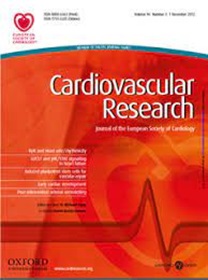Nrf3-Trim5轴在血管平滑肌细胞功能障碍和新生内膜增生中的新作用。
IF 13.3
1区 医学
Q1 CARDIAC & CARDIOVASCULAR SYSTEMS
引用次数: 0
摘要
以血管平滑肌细胞(VSMC)功能障碍为特征的内膜增生(NIH)在动脉粥样硬化和再狭窄等许多血管疾病中起着关键作用,导致严重的缺血性并发症,治疗方法有限。我们之前的研究证实了核因子红系2相关因子3 (Nrf3)在VSMC分化中的关键作用。然而,对Nrf3在NIH中的功能意义知之甚少。方法与结果利用转录组数据集和人类动脉粥样硬化样本检测Nrf3的表达水平。采用全球通(Nrf3-/-)和VSMC特异性(Nrf3ΔSMC) Nrf3敲除小鼠来评估Nrf3在VSMC功能和损伤性NIH中的作用。利用互补分子方法鉴定Nrf3下游靶点,阐明Nrf3在靶基因调控中的调控作用。采用猪颈动脉支架模型验证Nrf3抑制对血管重构的治疗作用。转录组学数据和免疫染色分析显示Nrf3水平升高,Nrf3和NIH在人类动脉粥样硬化血管中呈正相关。多种病理生理刺激诱导内质网(ER)应激,通过激活转录因子4 (ATF4)增强Nrf3表达。Nrf3过表达促进人和小鼠VSMC增殖、迁移和炎症反应,而Nrf3缺失或敲低则相反。Nrf3-/-和Nrf3ΔSMC小鼠显示VSMC积累减少和血管损伤诱导的NIH减弱。在机制上,Trim5是冠状动脉疾病的遗传风险位点,在VSMCs和受损动脉中被确定为Nrf3的功能性下游靶点。Nrf3通过上调Trim5表达增强VSMCs和损伤动脉的自噬,进而促进VSMCs功能障碍,从而增加损伤诱导的NIH。重要的是,在Nrf3-/-小鼠中恢复Nrf3或Trim5的表达可以挽救在Nrf3-/-小鼠中观察到的动脉表型。关键的是,通过血管周围给予Nrf3抑制剂抑制Nrf3的表达,可以显著减少猪颈动脉球囊和支架置入引起的再狭窄。结论Nrf3是VSMC功能障碍和损伤性NIH的一种新型调节剂。Nrf3通过转录激活Trim5基因发挥其病理功能,从而触发VSMCs和损伤动脉的自噬,促进动脉重塑。抑制Nrf3-Trim5信号轴可改善损伤性NIH,为治疗NIH相关血管疾病患者提供新的治疗方法。本文章由计算机程序翻译,如有差异,请以英文原文为准。
Novel roles of Nrf3-Trim5 axis in vascular smooth muscle cell dysfunctions and neointimal hyperplasia.
AIMS
Neointimal hyperplasia (NIH) characterized by vascular smooth muscle cell (VSMC) dysfunctions plays a critical role in many vascular diseases including atherosclerosis and restenosis, which leads to serious ischemic complications and has limited therapeutic approaches. Our previous studies confirm a critical role for nuclear factor erythroid 2-related factor 3 (Nrf3) in VSMC differentiation. However, little is known about the functional implications of Nrf3 in NIH.
METHODS AND RESULTS
Transcriptome dataset and human atherosclerotic samples were used to determine Nrf3 expression levels. Global (Nrf3-/-) and VSMC-specific (Nrf3ΔSMC) Nrf3 knockout mice were used to assess the role of Nrf3 in VSMC function and injury-induced NIH. Complementary molecular methods were performed to identify Nrf3 downstream targets and elucidate the regulatory role of Nrf3 in target gene regulation. Porcine carotid stenting model was used to validate the therapeutic effects of Nrf3 inhibition in vascular remodeling.Transcriptomic data and immunostaining analysis showed increased levels of Nrf3, and a positive correlation between Nrf3 and NIH in the human atherosclerotic vessels. Various pathophysiological stimuli induced endoplasmic reticulum (ER) stress which enhanced Nrf3 expression via Activating Transcription Factor 4 (ATF4). Nrf3 overexpression promoted both human and mouse VSMC proliferation, migration, and inflammatory response, while opposite effects were observed when Nrf3 was deleted or knockdown. Nrf3-/- and Nrf3ΔSMC mice showed decreased VSMC accumulation and attenuated vascular injury-induced NIH. Mechanistically, tripartite motif-containing 5 (Trim5), a genetic risk locus for coronary artery disease, was identified as a functional downstream target of Nrf3 in VSMCs and in injured arteries. Nrf3 enhanced autophagy in VSMCs and injured arteries by upregulating Trim5 expression, which subsequently promoted dysfunctions of VSMCs, thereby increasing injury-induced NIH. Importantly, restoring either Nrf3 or Trim5 expression in Nrf3-/- mice rescued the arterial phenotypes observed in Nrf3-/- mice. Critically, the porcine carotid artery restenosis induced by ballooning and stenting was significantly reduced by suppressing Nrf3 expression through perivascular administration of the Nrf3 inhibitors.
CONCLUSIONS
We comprehensively demonstrate that Nrf3 is a novel modulator in VSMC dysfunctions and injury-induced NIH. Nrf3 exerts its pathological functions by transcriptional activation of Trim5 gene, which in turn triggers autophagy in VSMCs and injured arteries, promoting arterial remodeling. Inhibiting the Nrf3-Trim5 signal axis ameliorates injury-induced NIH, offering novel therapeutics for treating patients with NIH-related vascular diseases.
求助全文
通过发布文献求助,成功后即可免费获取论文全文。
去求助
来源期刊

Cardiovascular Research
医学-心血管系统
CiteScore
21.50
自引率
3.70%
发文量
547
审稿时长
1 months
期刊介绍:
Cardiovascular Research
Journal Overview:
International journal of the European Society of Cardiology
Focuses on basic and translational research in cardiology and cardiovascular biology
Aims to enhance insight into cardiovascular disease mechanisms and innovation prospects
Submission Criteria:
Welcomes papers covering molecular, sub-cellular, cellular, organ, and organism levels
Accepts clinical proof-of-concept and translational studies
Manuscripts expected to provide significant contribution to cardiovascular biology and diseases
 求助内容:
求助内容: 应助结果提醒方式:
应助结果提醒方式:


